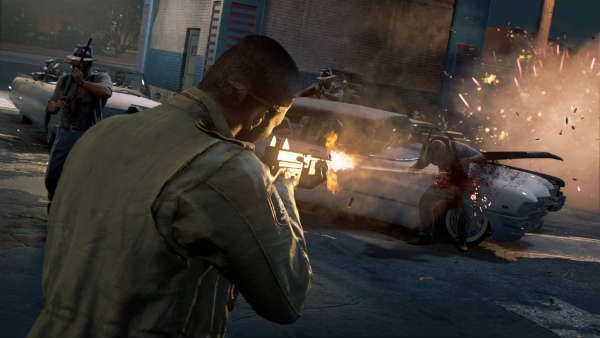“The easiest, simplest thing we do is give up,” says Charles Laveau, host of a pirate radio station in Mafia 3’s New Bordeaux, a fictionalized, 1968 New Orleans “Let everything go and do exactly what we told: be good obedient niggers. But what kinda life we leadin’ then? The violence goes away, but along with it goes dignity, our pride.”
Laveau’s concern is clear, and though the game is set in the late 60s, it is resonant even today–just ask the folks who clapped when a character in last month’s Black Panther told us that “death was better than bondage.” But Laveau isn’t simply advocating for death, he’s joining a tradition of black radicalism that argues for armed resistance against racial and colonial oppression, and between his words and the actions of protagonist Lincoln Clay, Mafia 3 urges us to consider an aspect of the raging gun debate that is often left by the sideline.
Much of the recurring debate about guns in America centers on the creaking unwieldiness of the Second Amendment, which guarantees the right of citizens to keep and bear arms, and was originally intended to protect D.I.Y. militias during the colonial period. Gun-control advocates tend to talk about how the founders never foresaw high-powered rifles being invented, or how background checks should be required for gun purchases. The ignored downsides of background checks, such as the vilification of mental illness, and Muslims, reveal tellingly narrow perspectives among its proponents.
The narrowness doesn’t end there: Not only is after-the-fact gun-control a panacea of questionable effectiveness, it ignores the political history of guns in America. And it ignores the perspectives of the poor, the colonized and the people of color in this country, who continue to experience the realities of that history, and for whom relinquishing guns to a lethal state is an unappealing prospect at best. Getting to the root of this perspective means understanding the role the Second Amendment has played in shoring up white supremacist and colonialist violence in this country.
In “Loaded: A Disarming History of the Second Amendment,” Roxanne Dunbar-Ortiz writes that “…when firearms were no longer needed to appropriate Indigenous Peoples’ lands, the firearm became a representation of ongoing racist domination–a kind of war trophy–not just of Native Peoples and their territories, but of African Americans and the world.” Introduced while (soon to be ex) English colonists ravaged Indigenous communities in order to capture and speculate on their stolen land, the Second Amendment’s purpose was to help support their right to efficiently do so with the most effective tools at their disposal. These constitutionally protected militias then evolved into slave patrols, assembled to enforce slavery and limit free movement of black people before and after the civil war.
In 1966, Huey P. Newton and Bobby Seale decided to test the unspoken racist boundaries of the Second Amendment, which have always assumed the whiteness and maleness of the American gun owner, and started The Black Panther Party For Self-Defense. Despite the legislative changes brought about by the southern civil rights movement, Newton and Seale, in recognition of the country’s bloody roots, the legacy of slavery, and the daily violence visited upon them by the state, decided that armed self-defense would make a more powerful statement both to the state and to the black communities they hoped to organize. As Frantz Fanon, a major inspiration to the Panthers put it: “The mobilization of the masses, when it rises out of the war of liberation, introduces into each man’s consciousness the ideas of a common cause, of a national destiny and of a collective history.”
The Panthers emerged from an unstable and oppressive situation, based out of a depressed and deindustrialized Oakland, California. At the time, Oakland’s police force was no more than 4 percent black (Phil McArdle, “Oakland Police Department History 1955-1993”), and would regularly frisk, harass, beat and shoot Oakland’s poor black residents. The Watts riots of Los Angeles had happened only a few years earlier, the ‘67 Detroit riots a year later. Into this mix came the Black Panthers, heavily armed with pistols, shotguns, and rifles, walking tall and facing up to cops with a swagger and a sense of dignity that shocked everyone, the state most of all.
In effect, the Panthers were taking the same exhibited force and weaponry that had historically been used to oppress poor people of color and turning them into symbols of defiance, icons of resistance. As Newton wrote: “There is a world of difference between 30 million unarmed, submissive black people and 30 million black people armed with freedom and defense guns and the strategic methods of liberation.”
Mafia 3 employs this same energy in the fantasy it empowers, tapping into the militant and pro-gun spirit of groups like the Panthers with its choice of hero (a militant, black Vietnam war-vet) and its setting (a southern town boiling over with racism in 1968). While it sits comfortably within an extensive stable of games where shooting people is the primary method of interaction, Mafia 3, through its black power-inspired hero and roiling 60’s setting, surfaces a different, rebellious vision of what guns ought to be used for, and who ought to wield them…
Continue reading on Waypoint

